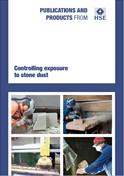Silica in Stoneworking
NEW ADVICE FOR INSTALLERS OF STONE WORKTOPS
The Health and Safety Executive (HSE) has created new advice for installers, their managers and supervisors who are involved in the installation of stone worktops.
HSE has created this in partnership with industry to help employers protect workers from the risks of silica dust, respirable crystalline silica (RCS).
This advice provides those involved with simplified information covering: Competent staff & effective processes, Pre-Installation, On-site Installation, and Post-installation.
You can download the table here: HSE guidance for those installing stone worktops
More detailed guidance pages for installers are available on the HSE website: Installing stone worktops: protect against harmful natural or artificial stone dust – HSE
The British Occupational Hygiene Society (BOHS) has created a useful presentation, Silica Dust: Risks when working with Engineered Stone, to view the Power Point Presentation click the link: PowerPoint Presentation
Task specific advice for stonework
HSE provides a range of guidance and advice on its website here: Stoneworkers: Health and safety topics – Silica dust
Stonework task specific advice can be found on the COSHH sheets here: Stoneworkers – COSHH (hse.gov.uk)
This includes advice on primary and secondary sawing, rotary tools, cutting and polishing and sawing slate.
CONTROL EXPOSURE TO KEEP WORKERS SAFE
Respirable crystalline silica (RCS) is generated during the working of stone in the stone manufacturing, processes such as cutting, chiselling and polishing, can generate high levels of stone dust containing RCS. When these materials are worked, dust is created which may be fine enough to be breathed deep into the lungs and cause devastating lung diseases including silicosis, chronic obstructive pulmonary disease (COPD) and lung cancer. These lung diseases ruin not only the lives of those that are suffering, but also their friends and families lives. Although irreversible, these diseases are preventable.
WHAT EMPLOYERS NEED TO KNOW
Exposure to RCS is subject to the Control of Substances Hazardous to Health Regulations 2002 (COSHH). As an employer, you are legally responsible for taking effective measures to control exposure and protect workers’ health. These measures can also improve production or cut waste.
Effective control is likely to be achieved by a mixture of controls including local exhaust ventilation (LEV) for dust extraction, respiratory protection equipment (RPE), water suppression and process changes.
The amount of dust workers are exposed to depends on a numbers of factors including:
- the type of stone they are working (including both natural and artificial/engineered stone);
- the type of tool they are using and whether it is a powered or hand held tool
- how long they are working with the tool;
- how well you are using any extraction system (local exhaust ventilation);
- the effectiveness of a mask (respiratory protective equipment);
- how your workshop is organised (including segregation of dusty activities and housekeeping arrangements).
HEALTH SURVEILLANCE
Health surveillance for silicosis should be considered for workers who are involved in high-risk occupations, including cutting, chiselling
and polishing.
Guidance is available in Health surveillance for those exposed to respirable crystalline silica (RCS) G404. (PDF)







